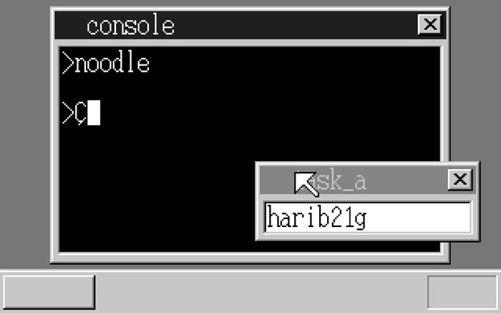8 取消定时器(harib21h)
上一节我们所实现的定时器功能,其实有个问题,接下来我们来解决它。
这个问题是在应用程序结束之后发生的,请大家想象一下noodle.hrb结束之后的情形。应用程序设置了一个1秒的定时器,当定时器到达指定时间时会产生超时,并向任务发送事先设置的数据。问题是,如果这时应用程序已经结束了,定时器的数据就会被发送到命令行窗口,而命令行窗口肯定是一头雾水。
为了确认这个问题,我们在harib21g中运行noodle.hrb,按回车键或者其他任意键结束程序看看。大约1秒钟之后,命令行窗口中会自动出现一个神秘的字符。用鼠标按“×”关闭窗口之后,也会出现同样的现象。

noodle.hrb结束后出现的神秘字符(不是C哦)
要解决这个问题,我们需要取消待机中的定时器,这样一来,就可以在应用程序结束的同时取消定时器,问题也就迎刃而解了。
■■■■■
首先我们来编写用于取消指定定时器的函数。
本次的timer.c节选
int timer_cancel(struct TIMER *timer){int e;struct TIMER *t;e = io_load_eflags();io_cli(); /*在设置过程中禁止改变定时器状态*/if (timer->flags == TIMER_FLAGS_USING) { /*是否需要取消?*/if (timer == timerctl.t0) {/*第一个定时器的取消处理*/t = timer->next;timerctl.t0 = t;timerctl.next = t->timeout;} else {/*非第一个定时器的取消处理*//*找到timer前一个定时器*/t = timerctl.t0;for (;;) {if (t->next == timer) {break;}t = t->next;}t->next = timer->next; /*将之前“timer的下一个”指向“timer的下一个”*/}timer->flags = TIMER_FLAGS_ALLOC;io_store_eflags(e);return 1; /*取消处理成功*/}io_store_eflags(e);return 0; /*不需要取消处理*/}
详细的解说已经写在程序的注释中了,请大家自行阅读。
接下来,我们来编写在应用程序结束时取消全部定时器的函数。在此之前,我们需要在定时器上增加一个标记,用来区分该定时器是否需要在应用程序结束时自动取消。如果没有这个标记的话,命令行窗口中用来控制光标闪烁的定时器也会被取消掉了。
本次的bootpack.h节选
struct TIMER {struct TIMER *next;unsigned int timeout;char flags, flags2; /*这里!*/struct FIFO32 *fifo;int data;};
通常情况下,这里的flags2为0,为了避免忘记置0,我们来修改一下timer.alloc。
本次的timer.c节选
struct TIMER *timer_alloc(void){int i;for (i = 0; i < MAX_TIMER; i++) {if (timerctl.timers0[i].flags == 0) {timerctl.timers0[i].flags = TIMER_FLAGS_ALLOC;timerctl.timers0[i].flags2 = 0; /*这里!*/return &timerctl.timers0[i];}}return 0; /*没有找到*/}
接下来,我们将应用程序所申请的定时器的flags2设为1。
本次的console.c节选
int *hrb_api(int edi, int esi, int ebp, int esp, int ebx, int edx, int ecx, int eax){(中略)} else if (edx == 16) {reg[7] = (int) timer_alloc();((struct TIMER *) reg[7])->flags2 = 1; /*允许自动取消*/ /*这里!*/} else if (edx == 17) {(中略)}
准备完成了,下面我们就编写一个函数,来取消应用程序结束时所不需要的定时器。
本次的console.c节选
int cmd_app(struct CONSOLE *cons, int *fat, char *cmdline){(中略)if (finfo != 0) {(中略)if (finfo->size >= 36 && strncmp(p + 4, "Hari", 4) == 0 && *p == 0x00) {(中略)start_app(0x1b, 1003 * 8, esp, 1004 * 8, &(task->tss.esp0));shtctl = (struct SHTCTL *) *((int *) 0x0fe4);for (i = 0; i < MAX_SHEETS; i++) {sht = &(shtctl->sheets0[i]);if ((sht->flags & 0x11) == 0x11 && sht->task == task) {/*找到应用程序残留的窗口*/sheet_free(sht); /*关闭*/}}timer_cancelall(&task->fifo); /*这里!*/memman_free_4k(memman, (int) q, segsiz);} else {(中略)}(中略)}(中略)}
本次的timer.c节选
void timer_cancelall(struct FIFO32 *fifo){int e, i;struct TIMER *t;e = io_load_eflags();io_cli(); /*在设置过程中禁止改变定时器状态*/for (i = 0; i < MAX_TIMER; i++) {t = &timerctl.timers0[i];if (t->flags != 0 && t->flags2 != 0 && t->fifo == fifo) {timer_cancel(t);timer_free(t);}}io_store_eflags(e);return;}
大功告成了!
我们来“make run”,运行noodle.hrb,然后让程序结束。哦哦成功了,神秘字符再也不出现了,太好了。

神秘字符消失了
好了,今天的内容就到这里吧,明天见哦!
